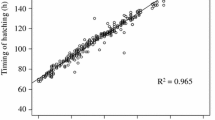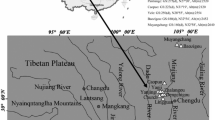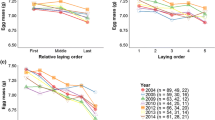Abstract
Hatching asynchrony (HA hereafter) leads to patent age and size hierarchies within broods of altricial birds, disadvantaging runts through a reduced condition/survival. The function of HA is controversial, although a general hypothesis states that HA would be an adaptive maternal mechanism for maximizing reproductive output under particular ecological conditions. Accordingly, when ecological conditions are not favourable, asynchronous broods would outperform synchronous broods because the formers would allow for an adaptive adjustment of brood size. A poorly untested prediction emerging from this hypothesis is that the adaptive value of HA should change with environmental conditions in relatively long time windows within a population. Using data from 8 years of a population of the asynchronous European roller Coracias garrulus, we studied variation in HA and fecundity selection on HA. Hatching span (ranging from 1 to 8 days) was longer in larger broods and later in the breeding season. Interestingly, we found that asynchronous broods were more fecund than synchronous ones in colder and drier years in April, which is the previous month to reproduction, and the opposite was true in years with warmer but rainier Aprils. Given that warmer and rainier Aprils relate to advanced and increased arthropod availability in the Mediterranean region, these results would suggest that HA in rollers might function as an adaptive trait that provides parents of asynchronous broods with some benefits in years with low productivity, in agreement with the Lack’s brood reduction hypothesis, and illustrate the relevance of studying the adaptive value of HA over gradients of environmental conditions.



Similar content being viewed by others
References
Amundsen, T., & Slagsvold, T. (1996). Lack’s brood reduction hypothesis and avian hatching asynchrony: What’s next? Oikos, 76, 613–620.
Arnold, T. W. (2011). An experimental study of fledging success in American coots (Fulica americana): effects of brood size, food availability, and hatching asynchrony. Auk, 128, 737–745.
Avilés, J. M., & Parejo, D. (1997). Dieta de los pollos de carraca (Coracias garrulus) en una zona mediterránea (Extremadura, suroeste de España). Ardeola, 44, 234–239.
Avilés, J. M., Parejo, D., & Rodríguez, J. (2011). Parental favouritism strategies in the asynchronously hatching European roller (Coracias garrulus). Behavioral Ecology and Sociobiology, 65, 1549–1557.
Avilés, J. M., Sánchez, J. M., Sánchez, A., & Parejo, D. (1999). Breeding biology of the roller Coracias garrulus in farming areas of the southwest Iberian Peninsula. Bird Study, 46, 217–223.
Bortolotti, G. R., & Wiebe, K. L. (1993). Incubation behavior and hatching patterns in the American kestrel Falco sparverius. Ornis Scandinavica, 24, 41–47.
Chaine, A. S., & Lyon, B. E. (2008). Adaptive plasticity in female mate choice dampens sexual selection on male ornaments in the lark bunting. Science, 319, 459–462.
Clark, A. B., & Wilson, D. S. (1981). Avian breeding adaptations: Hatching asynchrony, brood reduction, and nest failure. Quarterly Review of Biology, 56, 253–277.
Coca-Abia, M. M., Tenas-Pérez, I., Giménez-Legarre, S., & García-Muñoz, E. (2010). A preliminary study of the biology of the grasshopper Calliptamus wattenwylianus (Orthoptera; Acrididae). Boletín de Sanidad Vegetal, Plagas, 36, 149–155.
Cockburn, A., Osmond, H. L., & Double, M. C. (2008). Swingin’ in the rain: Condition dependence and sexual selection in a capricious world. Proceedings of the Royal Society, Series B, 275, 605–612.
Cramp, S., & Simmons, K. E. L. (1988). The birds of the western Palearctic. Oxford: Oxford University Press.
Etterson, J. R. (2004). Evolutionary potential of Chamaecrista fasciculata in relation to climate change. 1. Clinal patterns of selection along an environmental gradient in the great plains. Evolution, 58, 1446–1458.
Forbes, L. S. (1994). The good, the bad and the ugly: Lack’s brood reduction hypothesis and experimental design. Journal of Avian Biology, 25, 338–343.
Frampton, G. K., Van den Brink, P. J., & Gould, P. J. L. (2000). Effects of spring drought and irrigation on farmland arthropods in southern Britain. Journal of Applied Ecology, 37, 865–883.
Garant, D., Kruuk, L. E. B., McCleery, R. H., & Sheldon, B. C. (2004). Evolution in a changing environment: A case study with great tit fledging mass. The American Naturalist, 164, E115–E129.
Gilby, A. J. (2011). The adaptive benefit of hatching asynchrony in wild zebra finches. Animal Behaviour, 82, 479–484.
Gordo, O., Sanz, J. J., & Lobo, J. M. (2010). Determining the environmental factors underlying the spatial variability of insect appearance phenology for the honey bee, Apis mellifera, and the small white, Pieris rapae. Journal of Insect Science, 10, 1–21.
Grant, P. R., & Grant, B. R. (2002). Unpredictable evolution in a 30-year study of Darwin’s finches. Science, 296, 707–711.
Hebert, P. N., & McNeil, R. (1999). Hatching asynchrony and food stress in ring-billed gulls: An experimental study. Canadian Journal of Zoology, 77, 515–523.
Hussell, D. J. T. (1972). Factors affecting clutch size in arctic passerine. Ecological Monograph, 42, 317–364.
Hussell, D. J. T. (1985). On the adaptive basis for hatching asynchrony: Brood reduction, nest failure and asynchronous hatching in snow buntings. Ornis Scandinavica, 16, 205–212.
Illera, J. C., & Díaz, M. (2006). Reproduction in an endemic bird of a semiarid island: a food-mediated process. Journal of Avian Biology, 37, 447–456.
IPCC. (2007). Summary for policymakers. In S. Solomon, D. Qin, M. Manning, Z. Chen, & M. Marquis (Eds.), Climate change 2007: The physical science basis. Contribution of working group I to the fourth assessment report of the intergovernmental panel on climate change (pp. 1–35). Cambridge: Cambridge University Press.
Kontiainen, P., Pietiainen, H., Karell, P., Pihlaja, T., & Brommer, J. E. (2010). Hatching asynchrony is an individual property of female Ural owls which improves nestling survival. Behavioral Ecology, 21, 722–729.
Lack, D. (1966). Population studies of birds. Oxford: Clarendon.
Li, S. H., & Brown, J. L. (1999). Influence of climate on reproductive success in Mexican Jays. Auk, 116, 924–936.
Lindström, J. (1999). Early development and fitness in birds and mammals. Trends in Ecology & Evolution, 14, 343–348.
Magrath, R. D. (1989). Hatching asynchrony and reproductive success in the blackbird. Nature, 339, 536–538.
Magrath, R. D. (1990). Hatching asynchrony in altricial birds. Biological Reviews of the Cambridge Philosophical Society, 65, 587–622.
Magrath, R. D. (1992). Seasonal changes in egg mass within and among cluthes of birds: General explanations and a field-study of the blackbird Turdus merula. Ibis, 134, 171–179.
Mock, D. W., & Forbes, L. C. (1994). Life-history consequences of avian brood reduction. Auk, 111, 115–123.
Møller, A. P. (2002). North Atlantic Oscillation (NAO) effects of climate on the relative importance of first and second clutches in a migratory passerine bird. Journal of Animal Ecology, 71, 201–210.
Nussey, D. H., Clutton-Brock, T. H., Elston, D. A., Albon, S. D., & Kruuk, L. E. B. (2005). Phenotypic plasticity in a maternal trait in red deer. Journal of Animal Ecology, 74, 387–396.
Parejo, D., & Avilés, J. M. (2011). Predation risk determines breeding territory choice in a Mediterranean cavity-nesting bird community. Oecologia, 165, 185–191.
Parejo, D., Avilés, J. M., Peña, A., Sánchez, L., Ruano, F., Zamora-Muñoz, C., & Martín-Vivaldi, M. (2013). Armed rollers: Does nestling’s vomit function as a defence against predators? PLoS One, 8, e68862.
Parejo, D., Avilés, J., & Rodríguez, J. (2012). Supplemental food affects egg size but not hatching asynchrony in rollers. Behavioral Ecology Sociobiology, 66, 1097–1105.
Parejo, D., Silva, N., & Avilés, J. M. (2007). Within-brood size differences affect innate and acquired immunity in roller Coracias garrulus nestlings. Journal of Avian Biology, 38, 717–725.
Pikanowski, B. C. (1992). A revision of Lack’s brood reduction hypothesis. The American Naturalist, 139, 1270–1292.
Quesada-Moraga, E., & Santiago-Álvarez, C. (2000). Temperature related effects on embryonic development in the mediterranean locust Dociostaurus maroccanus. Physiological Entomology, 25, 191–195.
Reimchen, T. E., & Nosil, P. (2002). Temporal variation in divergent selection on spine number in threespine stickleback. Evolution, 56, 2472–2483.
Robinson, M. R. (2008). Environmental heterogeneity generates fluctuating selection on a secondary sexual trait. Current Biology, 18, 751–757.
Rodríguez, J., Avilés, J. M., & Parejo, D. (2011). The value of nestboxes in the conservation of Eurasian Rollers Coracias garrulus in southern Spain. Ibis, 153, 735–745.
Rodríguez, C., & Bustamante, J. (2003). The effect of weather on lesser kestrel breeding success: Can climate change explain historical population declines? Journal of Animal Ecology, 72, 793–810.
Rotenberry, J. T., & Wiens, J. A. (1991). Weather and reproductive variation in shrubsteppe sparrows: A hierarchical analysis. Ecology, 72, 1325–1335.
Santiago-Álvarez, C., Quesada-Moraga, E., & Hernández-Crespo, P. (2003). Diapause termination and postdiapause development in the Mediterranean locust Dociostaurus maroccanus (Orthoptera: Acrididae) under field conditions. Journal of Applied Entomology, 127, 369–373.
Sillett, T. S., Holmes, R. T., & Sherry, T. W. (2000). Impacts of a global climate cycle on population dynamics of a migratory songbird. Science, 288, 2040–2042.
Skagen, S. K. (1988). Asynchronous hatching and food limitation: A test of Lack’s hypothesis. Auk, 105, 78–88.
Stenning, M. J. (1996). Hatching asynchrony, brood reduction and other rapidly reproducing hypotheses. Trends in Ecology & Evolution, 11, 243–246.
Stoleson, S. H., & Beissinger, S. R. (1995). Hatching asynchrony and the onset of incubation in birds, revisited. When is the critical period? Current Ornithology, 12, 191–270.
Stoleson, S. H., & Beissinger, S. R. (1997). Hatching asynchrony, brood reduction, and food limitation in a neotropical parrot. Ecological Monograph, 67, 131–154.
Szollosi, E., Rosivall, B., & Torok, J. (2007). Is hatching asynchrony beneficial for the brood? Behavioral Ecology, 18, 420–426.
Theofanellis, T., Galinou, E., & Akriotis, T. (2008). The role of hatching asynchrony in brood size reduction of the great tit Parus major in a Mediterranean pine forest. Journal of Natural History, 42, 375–380.
Valkama, J., Korpimaki, E., Holm, A., & Hakkarainen, H. (2002). Hatching asynchrony and brood reduction in Tengmalm’s owl Aegolius funereus: The role of temporal and spatial variation in food abundance. Oecologia, 133, 334–341.
Wang, J. M., & Beissinger, S. R. (2011). Partial incubation in birds: Its ccurrence, function, and quantification. Auk, 128, 454–466.
Weatherhead, P. J. (2005). Effects of climate variation on timing of nesting, reproductive success, and offspring sex ratios of red-winged blackbirds. Oecologia, 144, 168–175.
Wellicome, T. I. (2005). Hatching asynchrony in Burrowing Owls is influenced by clutch size and hatching success but not by food. Oecologia, 142, 326–334.
Wiebe, K. L. (1995). Explaining intraspecific variation in hatching asynchrony: Should birds choose optimal hatching patterns? Oikos, 74, 453–462.
Wiebe, K. L., & Bortolotti, G. R. (1994). Energetic efficiency of reproduction: The benefits of asynchronous hatching for American kestrels. Journal of Animal Ecology, 63, 551–560.
Wiebe, K. L., & Bortolotti, G. R. (1995). Food-dependent benefits of hatching asynchrony in American kestrels Falco sparverius. Behavioral Ecology and Sociobiology, 36, 49–57.
Acknowledgments
We thank J. Rodríguez-Ruiz and F. Goytre who helped us with data collection. This study was funded by the Spanish Ministry of Education and Science/FEDER through the Projects CGL2005-04654/BOS, CGL2008-00718/BOS and CGL2011-27561/BOS to DP and JMA, PIE 200930I029 to JMA and by the Government of Extremadura through the contract TA13002 to DP.
Author information
Authors and Affiliations
Corresponding author
Ethics declarations
Conflict of interest
The authors declare that they do not have conflict of interest.
Ethical Statement
Data was collected under license of the Junta de Andalucía, Spanish region in which the study was done. Therefore, data collection complies with the current laws of Spain, where the study was performed.
Electronic supplementary material
Below is the link to the electronic supplementary material.
Rights and permissions
About this article
Cite this article
Parejo, D., Avilés, J.M. & Expósito, M. Hatching Asynchrony and Spring Climatic Conditions in the European Roller. Evol Biol 42, 443–451 (2015). https://doi.org/10.1007/s11692-015-9337-4
Received:
Accepted:
Published:
Issue Date:
DOI: https://doi.org/10.1007/s11692-015-9337-4




